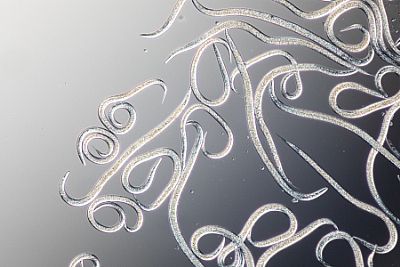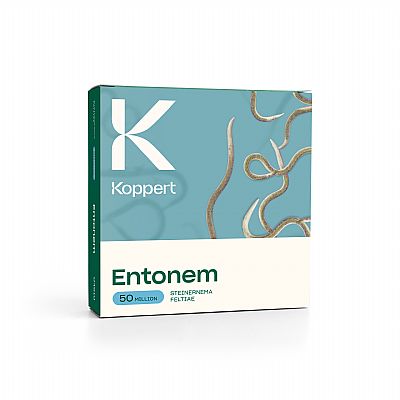ENTONEM / Steinernema feltiae
Entomopathogenic nematodes
Target
Use Entonem for the biological control of:
-
DipteraSciarids flies larvae (Lycoriella spp, Bradysia spp.) Leafminer larvae (Liriomyza spp.) Shore fly larvae (Scatella spp.)
-
ThysanopteraThrips pupae and larvae (Frankliniella occidentalis)
-
Coleoptera - WeevilsBlack vine weevil larvae (Otiorhynchus sulcatus) Other weevil larvae (Otiorhynchus spp.)
-
Lepidoptera - CaterpillarsTomato leaf miner larvae (Tuta absoluta) Noctuids larvae Armyworms (Spodoptera spp.), Cotton bollworm, Corn earworm (Helicoverpa spp.), tomato looper (Chrysodeixis chalcites), cutworms (Agrotis sp.), silver y moth (Autographa gamma). Oak processionary moth larvae (Thaumetopoea processionea) Common swift moth larvae (Korscheltellus lupulina)
-
HemipteraSycamore lace bug (Corythucha ciliata)
Packing
Each box contains entomopathogenic nematodes in an inert carrier material. 86% Steinernema feltiae - 14% inert carrier
-
50 million - 1 sachet in a box
-
500 million - 2 sachets of 250 million in a box
Dosage ENTONEM
| Rate (ind./m2) | m2/ unit | Frequency | Interval (days) | Remarks | |
| Preventive | - | - | - | - | |
| Light curative | 500.000 | 100/1.000 | 1x | - | |
| Heavy curative | 500.000 | 100/1.000 | 2 - 3x | 7 |
The information given below is merely indicative. Tailored advice can be provided if information is available on the local factors that need to be taken into account, such as the crop, the climate conditions and the level of infestation. For the correct approach, please consult a specialist of our company.
How does Entonem work
The nematodes enter the pest and release symbiotic bacteria into the body cavity. These bacteria convert the larval tissue into a food source, on which nematodes feed, develop, and reproduce. The host pest dies within a few hours to days after infection. The Infected host turns yellow to brown but may be difficult to find, due to rapid degradation in the growing media, or, as with foliar pest, it simply falls to the ground.
Application Entonem
Preparation of the spray solution:
-
Remove the sachets from their packaging and keep them for 30 minutes at room temperature.
-
Empty the contents of the sachets into a bucket containing at least 2 litres of water per sachet (water temperature: 15 - 20°C / 59 - 68°F).
-
Stir well and leave the contents to soak for five minutes.
-
Mix again and pour the contents into the half-filled spray tank (except when tank mixing with a compatible product).
-
Maintain agitation of mixture in the tank (e.g. with a recirculation pump).
-
Make up the spray tank with the required amount of water.
-
If tank mixing with a compatible product, add Entonem at the end to a fully filled tank.
Application
-
Nematodes can be applied using a watering can, an airblast sprayer, through a sprinkler system, with a backpack sprayer, or a vehicle-mounted spray unit.
-
To avoid blockage, all filters should be removed, especially if finer than 0.3 mm (50 mesh).
-
Use a maximum pressure of 20 bar / 290 psi (on nozzle).
-
The spray nozzle opening should be at least 0.5 mm (500 microns – 35 mesh) - preferably high flow rate cone nozzle types.
-
Continuous mixing should take place to prevent nematodes sinking to the bottom of the spray tank.
-
Avoid sprayers equipped with centrifugal or piston pumps.
-
Water tank temperature must not exceed 25°C (77°F) and pH must be between 4 to 8.
-
Distribute the spraying solution evenly over the soil/media surface.
-
Application through irrigation systems and/or Dosatron Venturi systems: pressure-compensated irrigation systems are recommended; if not available, spray or drench applications are recommended. For injection through Dosatron/Venturi systems, please contact your local representative for specific advice.
-
Spray the solution as soon as it is prepared and within a short timeframe (5 hours). Do not store mixed suspensions.
Best working conditions Entonem
-
Soil or air temperature below 5°C (41°F) and above 35°C (95°F) can be lethal - optimum between 14 and 26°C (55-80°F).
-
Nematodes are susceptible to ultraviolet light (UV): do not use them in direct sunlight; the moisture content of the soil must be kept high for several days after application. When possible, irrigate the crop before and right after application.
-
For foliar application, spray Entonem when relative humidity will exceed 75% for several hours post treatment; an adjuvant and/or an anti-desiccant/humectant additive can be beneficial. Ask your Koppert representative/distributor for more information.
-
Spray in the evening (or morning in some cases) allowing nematodes to work for several hours within the optimal range of temperature and humidity, as described above.
Handling
Biological beneficials have a very short life expectancy and therefore need to be introduced into the crop as soon as possible after receipt. Failure to do so can have a negative impact on their quality. In case you do need to store Entonem, please follow the instructions below.
Storage
-
Immediately upon receipt, take the box out of the shipment parcel.
-
Refrigerate at a temperature between 2°C and 6°C (35-43°F) in a ventilated refrigerator/cold room.
-
Keep away from direct sunlight.
-
Observe the use-by date shown on the box.
Pesticides can have (in)direct effects on beneficials. Check here




 HellasSITES
HellasSITES